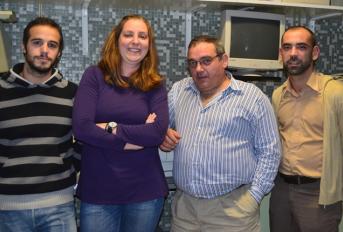Associação Portuguesa de Investigação em Cancro
Observing Cancer: The example of Thyroid Cancer
Observing Cancer: The example of Thyroid Cancer

One of the great challenges of modern molecular biology is the integration of new genetic information into procedures that can be implemented in rapid, cost effective and reliable methods to genotype, phenotype, identify gene function, and development treatment for the disease. One of the major impacts of such methods and procedures is the increase of our knowledge and understanding of human biology leading to the recognition of the importance of molecular factors in disease aetiology. The immediate consequence of such knowledge is an increased ability for pathology diagnostic and for the identification of presymptomatic individuals or those susceptible to specific diseases, improving our ability for disease prognosis and to develop more efficient therapeutic strategies. Here we have the example of Thyroid cancer, the most frequent endocrine neoplasia. However only 5 to 10% of all thyroid cancers are fatal. Exposure to ionizing radiation is the only verified cause of thyroid carcinogenesis in humans, especially when exposure occurs at a young age. However, individuals without previous exposure to ionizing radiation can also develop thyroid cancers, suggesting that other risk factors may also be involved in the aetiology of sporadic tumours.
Luís S. Santos1,2*, Bruno C. Gomes1*, Rita Gouveia1, Susana N. Silva1, Ana P. Azevedo1,3, Vanessa Camacho1, Isabel Manita4, Octávia M. Gil1,5, Teresa C. Ferreira6, Edward Limbert6, José Rueff1 and Jorge F. Gaspar1.
1.Depts. of Genetics and Biochemistry, Faculty of Medical Sciences, Universidade Nova de Lisboa (UNL), Lisboa, Portugal;
2.Health Sciences Institute, Universidade Católica Portuguesa (UCP), Viseu, Portugal;
3.Department of Clinical Pathology, Hospital de S. Francisco Xavier, Lisboa, Portugal;
4.Unit of Endocrinology, Hospital Garcia de Orta, Almada, Portugal;
5.Radiological Protection and Nuclear Safety Unit – Technological and Nuclear Campus, Instituto Superior Técnico, Universidade Técnica de Lisboa (UTL), Loures, Portugal;
6.Dept. Nuclear Medicine, Instituto Português de Oncologia de Lisboa, Lisboa, Portugal.
* Both authors contributed equally
Well-differentiated thyroid cancer (DTC) is the commonest form of thyroid cancer but, except for radiation exposure, etiology remains largely unknown. Several single nucleotide polymorphisms (SNPs) were already implicated in DTC risk. Nucleotide excision repair (NER) polymorphisms, despite having been associated with cancer risk at other locations, received little attention in the context of thyroid carcinogenesis. In order to evaluate the role of NER pathway SNPs on DTC susceptibility, we performed a case-control study in 106 Caucasian Portuguese DTC patients and 212 matched controls. rs2230641 (CCNH), rs2972388 (CDK7), rs1805329 (RAD23B), rs3212986 (ERCC1), rs1800067 (ERCC4), rs17655, rs2227869 (ERCC5), rs4253211 and rs2228529 (ERCC6) were genotyped using TaqMan® methodology, while conventional PCR-RFLP was employed for rs2228000 and rs2228001 (XPC). When considering all DTC cases, only rs2230641 (CCNH) was associated with DTC risk: a consistent increase in overall DTC risk was observed for both for the heterozygous genotype [OR=1.89; 95%CI=1.14-3.14] and for variant allele carriers [OR=1.79; 95%CI=1.09-2.93]. Histological stratification analysis confirmed an identical effect on follicular TC [OR=2.72; 95%CI=1.19-6.22, for heterozygous; OR=2.44; 95%CI=1.07-5.55, for variant allele carriers]. Considering papillary TC, the rs2228001 (XPC) variant genotype was associated with increased risk [OR=2.33; 95%CI=1.05-5.16], while a protective effect was observed for rs2227869 (ERCC5) [OR=0.26; 95%CI=0.08-0.90, for heterozygous; OR=0.25; 95%CI=0.07-0.86, for variant allele carriers]. No further significant results were observed. Our results suggest that NER polymorphisms such as rs2230641 (CCNH) and, possibly, rs2227869 (ERCC5) and rs2228001 (XPC), might influence DTC susceptibility. However, larger studies are required to confirm these results.
Journal:
Oncology Reports
http://www.spandidos-publications.com/or/30/5/2458




